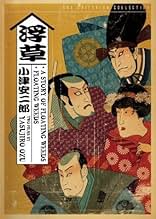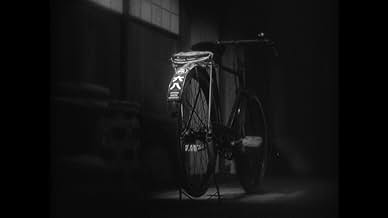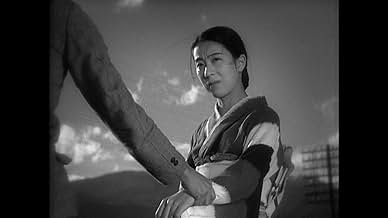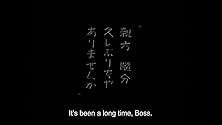AVALIAÇÃO DA IMDb
7,6/10
3,7 mil
SUA AVALIAÇÃO
Adicionar um enredo no seu idiomaA kabuki actor's mistress hatches a jealous plot to bring down her lover's son.A kabuki actor's mistress hatches a jealous plot to bring down her lover's son.A kabuki actor's mistress hatches a jealous plot to bring down her lover's son.
- Prêmios
- 1 vitória no total
Kôji Mitsui
- Shinkichi
- (as Hideo Mitsui)
Emiko Yagumo
- Otaka
- (as Rieko Yagumo)
Chishû Ryû
- Shouting audience member
- (não creditado)
- Direção
- Roteiristas
- Elenco e equipe completos
- Produção, bilheteria e muito mais no IMDbPro
Avaliações em destaque
People float, their stories, the roles they perform and worlds they bring to life, this is the main thrust of the film.
So I have been recently surveying early Ozu as part of two personal quests: the first of these is where I'm looking for images of some purity from the first hours of cinema. The film is fine in this regard, Ozu's most renowned silent film about a kabuki actor returning with his troupe to his hometown to confront a difficult past. There is concentrated mind, a clear gaze. Composed shots, especially outdoors. But hardly any noticeable difference from his previous films. Why this is held in comparatively higher esteem than say Dragnet Girl or Passing Fancy, I posit has a lot to do with a more overt Japaneseness.
Earlier Ozus were distinctly modern: I Was Born But.. about schoolkids growing up in a rapidly Westernized Japan, Dragnet Girl about a young boxer drawn to the excitement of gangster life. Tokyo Woman unraveled like what was called a 'kammerspiel' in Weimar Germany. There was no benshi narrating these, as was the traditional norm adopted from Japanese theater. They employed the Western fashion of intertitles. Western garb for the leading players. References to movies, music records, boxing, corporate or factory work.
But this one has some of that exotic appeal that first fascinated the rest of the world about Japan. The same thing as the Mizoguchi revival in the 50's. For some reason, Western viewers are a lot more receptive to Japanese films that validate idealized preconceptions.
Now my other quest where this fits into, is films that visually or otherwise exemplify the karmic resonances that move our worlds. What kindles our emotional fires. In the best of cases, this means a storytelling part governed by a set of abstract parameters that control how we tell that story. How the world is in turn colored and appears to us. At around this time, in the West this was primarily being developed as film noir.
The Japanese are some of the most reliable to turn to for this: cultural seclusion cultivating purity, plus many actual practices for doing so - from gardening to making tea. The effort is to embody the world as it comes into being, this is the level that Western art has rarely managed to attain. It's worth getting to know about these things, if only to shatter those preconceptions. A tea ceremony is not about pomp or quaint etiquette but meditation.
So here we have a man who has abandoned his child and run off to play roles on a stage. Turns out he has become known for what is grouped together in kabuki as bandit plays, folk legends about heroic scoundrels. (a famous example of these that you have the chance to see adopted to film and from this era, is Kochiyama Soshun by Sadao Yamanaka).
Presumably this is how he views himself, a man who is wrong by conventional standards but deep inside pure.
Now and then he returns home, again playing a role. This early misdeed returns to haunt him: his son is seduced by a woman from his troupe, another actor performing a role. He learns the truth and in turn seems ready to run off. The whole thing replicates itself, recycling the same floating story. Only forgiveness can sever the destructive karma that has been set in motion.
Again this is fine and the film worth watching. What it's missing however, I believe is an additional layer that resolved ordinary drama on stage, conflating performance of the inner story with the one we are watching as our film about it. Transitory but precious humanity, rendered visually as a play passing through town. A lot of room for improvisation, as real life shapes the thing.
Imbalance that reflects impermanence is the key. Instead we get balanced drama.
If you have time and the resources and as example of what I'm talking about, I recommend that you look for a silent French film called Eldorado from '21, where a female dancer sublimates motherly woes into seductive dance. It is more primitive in some ways, but in others not.
So I have been recently surveying early Ozu as part of two personal quests: the first of these is where I'm looking for images of some purity from the first hours of cinema. The film is fine in this regard, Ozu's most renowned silent film about a kabuki actor returning with his troupe to his hometown to confront a difficult past. There is concentrated mind, a clear gaze. Composed shots, especially outdoors. But hardly any noticeable difference from his previous films. Why this is held in comparatively higher esteem than say Dragnet Girl or Passing Fancy, I posit has a lot to do with a more overt Japaneseness.
Earlier Ozus were distinctly modern: I Was Born But.. about schoolkids growing up in a rapidly Westernized Japan, Dragnet Girl about a young boxer drawn to the excitement of gangster life. Tokyo Woman unraveled like what was called a 'kammerspiel' in Weimar Germany. There was no benshi narrating these, as was the traditional norm adopted from Japanese theater. They employed the Western fashion of intertitles. Western garb for the leading players. References to movies, music records, boxing, corporate or factory work.
But this one has some of that exotic appeal that first fascinated the rest of the world about Japan. The same thing as the Mizoguchi revival in the 50's. For some reason, Western viewers are a lot more receptive to Japanese films that validate idealized preconceptions.
Now my other quest where this fits into, is films that visually or otherwise exemplify the karmic resonances that move our worlds. What kindles our emotional fires. In the best of cases, this means a storytelling part governed by a set of abstract parameters that control how we tell that story. How the world is in turn colored and appears to us. At around this time, in the West this was primarily being developed as film noir.
The Japanese are some of the most reliable to turn to for this: cultural seclusion cultivating purity, plus many actual practices for doing so - from gardening to making tea. The effort is to embody the world as it comes into being, this is the level that Western art has rarely managed to attain. It's worth getting to know about these things, if only to shatter those preconceptions. A tea ceremony is not about pomp or quaint etiquette but meditation.
So here we have a man who has abandoned his child and run off to play roles on a stage. Turns out he has become known for what is grouped together in kabuki as bandit plays, folk legends about heroic scoundrels. (a famous example of these that you have the chance to see adopted to film and from this era, is Kochiyama Soshun by Sadao Yamanaka).
Presumably this is how he views himself, a man who is wrong by conventional standards but deep inside pure.
Now and then he returns home, again playing a role. This early misdeed returns to haunt him: his son is seduced by a woman from his troupe, another actor performing a role. He learns the truth and in turn seems ready to run off. The whole thing replicates itself, recycling the same floating story. Only forgiveness can sever the destructive karma that has been set in motion.
Again this is fine and the film worth watching. What it's missing however, I believe is an additional layer that resolved ordinary drama on stage, conflating performance of the inner story with the one we are watching as our film about it. Transitory but precious humanity, rendered visually as a play passing through town. A lot of room for improvisation, as real life shapes the thing.
Imbalance that reflects impermanence is the key. Instead we get balanced drama.
If you have time and the resources and as example of what I'm talking about, I recommend that you look for a silent French film called Eldorado from '21, where a female dancer sublimates motherly woes into seductive dance. It is more primitive in some ways, but in others not.
Early silent film from acclaimed Japanese director Yasujiro Ozu, "A Story of Floating Weeds" is an ostensibly simple tale of the head of an itinerant troupe of Kabuki players reconnecting with his teenage son Shinkichi (Koji Mitsui). The boy, who had been told that his father was a civil servant who had died, is a student 'with prospects' and the father does not want him to know of his humble origins. As he says to one of the female players in his troupe "My son belongs to a better world than yours", which of course, is the same world as his. Although the focus of the story is on the 'master' and his secret family, there are a number of entertaining scenes featuring the troupe as they are stuck in the town with their performances rained out, broke and bored, which much of the gentle humour coming at the expense of Tomi-boh (Tomio Aoki), the little boy with the errant bladder who plays a dog in the troupe's show. I watched an English-subtitled Criterion Edition on TCM and my only criticism is that the piano score seemed (IMO) too 'Western' for the setting (but I have no idea what the original music was like). The film is a slow-moving but poignant and beautifully filmed taste of pre-WW2 Japanese life. Later audiences would have found Shinkichi's mother's statement that he'll soon be old enough for the draft much more foreboding than Ozu could have intended. Remade by the same director as "Floating Weeds" in 1959.
I was able to see The Story of Floating Weeds for the first time recently, thanks to the Criterion Collection's DVD.
I was led to it when I came across Roger Ebert's list of his ten favorite films (written some time ago).
In his notes, Ebert claims Ozu shows us a "different cinematic language" but I find that kind of talk so much blather. Ozu uses his shots effectively to allow the actors to communicate the emotions being portrayed, especially necessary in this silent film.
A third rate company of traveling actors returns to a town after four years. The leader of the troupe had abandoned his lady in this town years before in order to tour with his company. He has fathered a son by the woman, whom he visits whenever he can, but his paternity is kept secret from his son.
What follows is the exposure of the secret and the effect it has on the lives of everyone involved, and some innocent bystanders as well.
The camera is almost always objective, the acting style is somewhat less melodramatic than in American silent films. There are excellent performances by all.
No time period is given for the story, but I have to assume it is earlier than the year the film was made (1934) because there are no automobiles, no radios, no telephones.
The enjoyment of Floating Weeds lies in the story itself and the ability of the director to tell it compellingly. If you demand car chases or food fights, this is not for you.
The Criterion DVD allows you to watch with or without the specially commissioned score. For first viewing, I recommend without.
I was led to it when I came across Roger Ebert's list of his ten favorite films (written some time ago).
In his notes, Ebert claims Ozu shows us a "different cinematic language" but I find that kind of talk so much blather. Ozu uses his shots effectively to allow the actors to communicate the emotions being portrayed, especially necessary in this silent film.
A third rate company of traveling actors returns to a town after four years. The leader of the troupe had abandoned his lady in this town years before in order to tour with his company. He has fathered a son by the woman, whom he visits whenever he can, but his paternity is kept secret from his son.
What follows is the exposure of the secret and the effect it has on the lives of everyone involved, and some innocent bystanders as well.
The camera is almost always objective, the acting style is somewhat less melodramatic than in American silent films. There are excellent performances by all.
No time period is given for the story, but I have to assume it is earlier than the year the film was made (1934) because there are no automobiles, no radios, no telephones.
The enjoyment of Floating Weeds lies in the story itself and the ability of the director to tell it compellingly. If you demand car chases or food fights, this is not for you.
The Criterion DVD allows you to watch with or without the specially commissioned score. For first viewing, I recommend without.
Warning: Some plot points are revealed in this review
One of the last silent films by Japanese master Yasujiro Ozu (later remade by Ozu himself in in color in 1959) is about a traveling kabuki troupe arriving to a small town in Japan. The troupe's leader, Kihachi (Takeshi Sakamoto) uses the occasion to meet his old lover and their grown son (who believes Kihachi is his uncle), but his current lover Otaka (pretty, ethereal Rieko Yagumo) does not appreciate this when she learns about it, so she convinces a fellow actress of the troupe to seduce Kihachi's son. Kihachi, obviously, doesn't react well either when he learns about this. Reportedly, Ozu based this film on an American film from 1928 called "The Barker".
There are few differences from the 1959 remake. For instance, here the kabuki troupe arrives to a mountain town in a train, instead of arriving to a coastal village by boat. Secondary characters are less shown. But mostly, both films are very similar, almost scene by scene, including the famous part where they are shouting over each other across a rainy street or the finale with Kihachi and his now reconciled lover drinking sake in the night train. The actor playing Kihachi, though, is about two decades younger than Ganjiro Nakamuro in the 1959 version.
Overall, this movie is not, in my opinion, as accomplished as the remake, but is still very well worth seeing, and one of the highlights of Ozu's silent films.
One of the last silent films by Japanese master Yasujiro Ozu (later remade by Ozu himself in in color in 1959) is about a traveling kabuki troupe arriving to a small town in Japan. The troupe's leader, Kihachi (Takeshi Sakamoto) uses the occasion to meet his old lover and their grown son (who believes Kihachi is his uncle), but his current lover Otaka (pretty, ethereal Rieko Yagumo) does not appreciate this when she learns about it, so she convinces a fellow actress of the troupe to seduce Kihachi's son. Kihachi, obviously, doesn't react well either when he learns about this. Reportedly, Ozu based this film on an American film from 1928 called "The Barker".
There are few differences from the 1959 remake. For instance, here the kabuki troupe arrives to a mountain town in a train, instead of arriving to a coastal village by boat. Secondary characters are less shown. But mostly, both films are very similar, almost scene by scene, including the famous part where they are shouting over each other across a rainy street or the finale with Kihachi and his now reconciled lover drinking sake in the night train. The actor playing Kihachi, though, is about two decades younger than Ganjiro Nakamuro in the 1959 version.
Overall, this movie is not, in my opinion, as accomplished as the remake, but is still very well worth seeing, and one of the highlights of Ozu's silent films.
This is one of the earliest Ozu films widely available, and the Criterion version is outstanding in quality.
Its a perfect example of Ozu at his best. Its a gem of a film - beautifully shot, a perfect structure, funny, sad and fascinating. The story is simple enough - a traveling troupe arrive at a town, not realizing the reason the chief actor picked the town is because an old flame of his lives here with his son. His current girlfriend in her jealousy tries to stir things up, but things don't turn out as either expect.
What is most striking about the film is just how modern it seems. The characters are believable and funny, the female characters are strong and willful, while even the minor characters are nicely sketched out. The acting is nothing short of brilliant, which makes the whole film very entertaining - this is no period piece of academic interest only, its a great work of art and a wonderful film - a masterpiece really.
Its a perfect example of Ozu at his best. Its a gem of a film - beautifully shot, a perfect structure, funny, sad and fascinating. The story is simple enough - a traveling troupe arrive at a town, not realizing the reason the chief actor picked the town is because an old flame of his lives here with his son. His current girlfriend in her jealousy tries to stir things up, but things don't turn out as either expect.
What is most striking about the film is just how modern it seems. The characters are believable and funny, the female characters are strong and willful, while even the minor characters are nicely sketched out. The acting is nothing short of brilliant, which makes the whole film very entertaining - this is no period piece of academic interest only, its a great work of art and a wonderful film - a masterpiece really.
Você sabia?
- CuriosidadesA Moxa treatment refers to the burning of an herb called moxa (aka mugwort) on, or directly above, the skin. Recipients of the treatment generally didn't like the burning sensation on their skin, although this was supposed to enhance circulation and lymphatic flow. Also, the scent of moxa is believed to have a soothing, relaxing effect, which would have been important to counteract the skin irritation.
- Citações
Kihachi: What did you plan to do with my son?
Otaka: Who cares about your son? He's cheap, like you, playing around with actresses.
[Kihachi beats Otaka]
Otaka: Are you sorry? I hope you'll be very sorry. The world is like a lottery. You take your ups and your downs. Let's make up please. That makes us even, you see. Just think how I feel.
- Cenas durante ou pós-créditosThe film title and credits are placed before a backdrop of plain sackcloth. This would become a trademark of Yasujirô Ozu films.
- ConexõesFeatured in Konbini: Pablo Larraín va faire un remake de Scarface? | Video Club (2025)
Principais escolhas
Faça login para avaliar e ver a lista de recomendações personalizadas
- How long is A Story of Floating Weeds?Fornecido pela Alexa
Detalhes
- Data de lançamento
- País de origem
- Idiomas
- Também conhecido como
- A Story of Floating Weeds
- Empresa de produção
- Consulte mais créditos da empresa na IMDbPro
- Tempo de duração
- 1 h 26 min(86 min)
- Cor
- Mixagem de som
- Proporção
- 1.37 : 1
Contribua para esta página
Sugerir uma alteração ou adicionar conteúdo ausente
























